The Artificial Intelligence & Robotics Center of Excellence
The Artificial Intelligence and Robotics is one of the centers of excellence which is identified by the ministry of science and technology to be established in Addis Ababa Science and Technology University. The Artificial Intelligence & Robotics center of excellence (AI&R CoEs) is established with the aim to create a close collaboration between the academia and industries in the fields of Artificial intelligence and robotics.
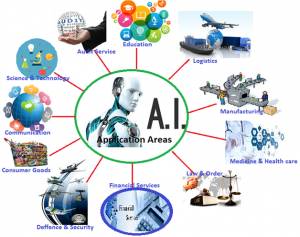
Mission of the center of Excellence
Establishing state of the art center of excellence that could serve the university community, researchers at the national and global levels in the fields of Artificial Intelligence and robotics. It could also be the hub for researchers to perform real problem solving research projects in the field of AI and robotics.
Vision of the center of Excellence
The vision of the center of excellence is promoting educational and research activities in the field of Artificial intelligence and robotics. The center has the vision of bridging the gap between industries and University with a distinctive capability to harness the intellectual energy of academia to impact Ethiopian industries with state of the art AI and robotics technologies.
Objectives of the center of excellence
The Artificial Intelligence & Robotics center of Excellence is established to fulfill the objectives bellow:-
- Strengthen industry academia linkage through close collaboration
- Promoting standard and real problem solving research works in the areas of AI and robotics
- Disseminate knowledge and expertise in the areas of AI and robotics
- To carry out advanced interdisciplinary research in the broad areas of Artificial Intelligence and robotics
- To generate trained manpower through degree programmes of MSc and Ph.D. in the fields of Artificial Intelligence and robotics
- To take up industrial projects with specific deliverables in the areas of Artificial Intelligence and robotics
- To conduct outreach programmes through workshops and training programmes to disseminate knowledge in interdisciplinary areas.
Identified research areas
.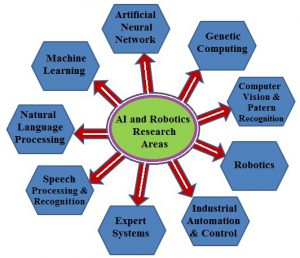
.
Artificial Neural Networks Research Area
The study of neural networks began with an aim to replicate the thought process of a human into a few microchips. It refers to huge data sets which are interconnected and continuously sending data to each other. Artificial Neural Network is a computational structure intended to mimic biological neural networks. Nueral network consist of computational units called neurons, which are connected by means of weighted interconnections. The mass of an interconnection is a quantity that states the strength of the associated interconnections. The foremost representative of AANs is their capability to study.
Some Basic Research areas under Artificial Neural network includes ,but not limited to:
- Character recognition
- Image Compression
- Stock market prediction
- Medicine, security, and loan applications
Evolutionary and Genetic Computing Research Area
In artificial intelligence, genetic computing is a technique whereby computer programs are encoded as a set of genes that are then modified (evolved) using an evolutionary algorithm often a genetic algorithm GA, it is an application of genetic algorithm where the space of solutions consists of computer programs. The results are computer programs are able to perform well in a predefined task. The methods used to encode a computer program in an artificial chromosome and to evaluate its fitness with respect to the predefined task are central in the GP technique and still the subject of active research.
Some Basic Research areas under Genetic Computing include but not limited to:
- Engineering design, Planning and scheduling
- Parameter and system identification
- Control and Robotics
- Pattern and Speech recognition
- Classifier system
- Optimized telecommunication routing
- Invention of biometrics
- Computer breaking and encryption
- Computerized molecular design
Computer Vision & pattern Recognition Research Area
Computer vision is the science and technology of gaining models, sense and control information from visual data. The dualistic key arenas of computer vision are computational vision and machine vision. Computational vision takes to ensure with simply recording and exploring the visual acuity, trying to recognize it. Machine vision has to do with means of what is found from computational vision and relating it to profit people, animals, environment, etc. Specific research areas include object recognition (including face analysis and recognition); 3D shape analysis from 2D images; brain image analysis (including tensor MRI and MEG); tracking; watermarking; quantum information processing; spectral graph theory; machine learning and reflectance modelling.
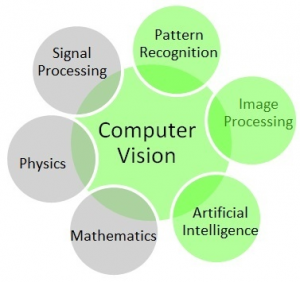
Some Basic Research areas under Computer Vision & pattern Recognition include but not limited to:
- Computer vision: pattern recognition, image processing, machine learning, biometrics.
- Machine learning with non-vectorial data: using ideas from spectral graph theory, description length and information theory to develop generative and discriminative models to data represented using graphs, trees or strings.
- Object recognition: using shape and structure to recognise objects in complex scenes, object recognition from large data-bases and video streams.
- Shape-from-shading and texture: developing statistical methods to recover 3D object shape from single images containing shading or texture patterns.
- Motion analysis: robust recovery of structure from motion, motion field analysis, object tracking using particle filters.
- Face image analysis: recovery of 3D facial shape from 2D images, face recognition, facial image synthesis, gender and ethnicity determination.
- Reflectance modelling: development of theoretical and empirical models for light reflectance from complex non-Lambertian surfaces, the used of polarisation information for 3D shape recovery, modelling skin reflectance.
- Image watermarking: statistical and geometric methods for watermarking 2D and 3D images, steganography.
- Image analysis: diffusion smoothing of non-Euclidean image data, analysis of vector and tensor fields.
- Brain imaging: algorithms for fibretractography from diffusion tensor MRI data, MEG data analysis, MEG shape perception and recognition experiments.
- Quantum computing: algorithms based on quantum walks for graph isomorphism and graph clustering.
Robotics Research Area
It is the area of artificial intelligence technology most pretty to community. In fact, robotics could be the area where AI can be supreme beneficial to mankind. It includes mechanical, generally computer controlled devices to accomplish tasks that necessitate extreme accuracy or monotonous or dangerous work by people. Traditional robotics uses AI design procedures to drive robot activities and works toward robots as mechanical devices that have to be industrialized and measured by human engineer. The autonomous robotics methodology recommends that robot could improve and control themselves independently. These robots are able to adjust to both indeterminate and imperfect information in continuously changing environment. This is probable by emulating the learning progression of single natural organism or through evolutionary robotics, which is to put on selective duplicate on people of robots. It lets a simulated development process grow adaptive robots.
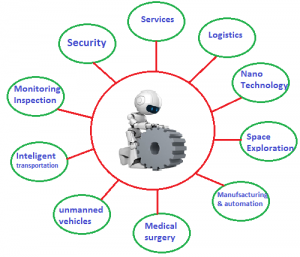
Some Basic Research areas under Robotics and industrial automation include but not limited to:
- Galaxy robotics– improvement of robot system for amorphous, uneven territory based on biologically enthused inventive kinetic energy perceptions
- Subaquatic robotics– development of schemes for user provision in remote controlled underwater vehicles retaining essential entanglement methods
- Rechargeable mobility– conceptions for electric vehicles, battery charge technologies, and the group of vehicle data. Prototypes for intellectual, environmentally sound, and integrated urban mobility are created.
- Logistics, production and consumer (LPC) robotics– novel systems are established which will improve handling and planning tasks, fast, self-learning image recognition and classification to identify construction faults.
- Search and rescue (SAR) and security robotics– robots will be technologically advanced to support rescue and security personnel, mission planning and independent navigation.
- Space exploration robotics– improvement of robot system to explore the outer space with improved efficiency and accuracy.
- Soft and Micro-robotics: soft active materials for actuation, sensing, and power of under-actuated compliant systems; meso-, micro-, and nano-scale robotic manipulation and assembly; untethered wireless microrobots; cm-to-mm scale aerial and ground robots.
- Bio-Inspired Robotics: Principles of aerial and aquatic locomotion in animals; Biologically inspired micro aerial vehicles and underwater robots; Dynamics and control of biological, bioinspired, and human-machine systems; Sensory skins for robot control; data gloves and haptics.
- Modular and Reconfigurable Robotics: reconfigurable, application specific robot topologies; robotically assembled, micro-scale modular building blocks; Reconfigurable/morphing structures for virtual design & interaction.
- Aerial Robotics: Unmanned aerial vehicle coordination and control, Micro-aerial vehicle design and control; Flying insect robots; aerodynamics and flight dynamics.
- Medical and Assistive Robotics: Minimally invasive robotic surgical tools; Sensory skins for platforms including wearable computing, injury prevention & rehabilitation; Assistive devices
Industrial Automation and control Research Area
Industrial Automation is the replacement with computers and machines to that of human thinking. The word Automation gives the meaning ‘self dictating’ or ‘a mechanism move by itself’ that derived from the Greek words Auto and Matos where auto means self while Matos means moving.
In a brief, industrial automation can be defined as the use of set technologies and automatic control devices that results the automatic operation and control of industrial processes without significant human intervention and achieving superior performance than manual control. These automation devices include PLCs, PCs, PACs, etc. and technologies include various industrial communication systems.

Application areas of Industrial Automation & Control
- Manufacturing: g., manufacturing motor parts for cars
- Robots: frequent reprogramming for new tasks, tool changes. simple embedded computer, hierarchical control
- Flexible Automation:numerous conveyors, robots, CNC machines, paint shops, logistics.
- Pharmaceutical Industry: Inventory, Recipe management, Packaging, Sampling, Tracking & tracing Comply with government rules
- Warehouses: extreme dependency on the availability of the control system Connection to:-supply chain management, order fulfillment, customer relationship and commercial accounting (SAP)
- Printing machines: tasks of control system: motor control (synchronization of the printing cylinders) ink and water control paper web control (reelstands (Rollenwechsler, bobines), web tension, emergency knife) interface to operator (commands, alarms)production preparation and statistics -up to the press room
- Oil & Gas, petrochemicals:“upstream”: from the earth to the refinery down-sea control “downstream”: from the oil to derived products special requirement: extreme, explosive environment distribution special requirement: high pressure, saltwater, inaccessibility explosive environment with gas. special requirement: environmental protection
- Chemical industry: logistics, local control of reactors Characterized by batches of products, reuse of production reactors for different product types (after cleaning).
- Process Industry: Process Industry = industries de transformation, Verfahrenstechnik (one of the many meanings of “process”) Examples:- Cement, Pulp & Paper, Metals and Minerals, Glass production, Chemical ….Continuous flow of materials, often 24 hours a day
- Building Automation: basics: fire, intrusion, climate, energy management, HVAC = Heat, Ventilation and Cooling visitors, meeting rooms, catering,…. low price tag
- Traffic control: fire, intrusion, energy, water, ventilation, pollution monitoring, cameras, light control, traffic jams prevention,….
- Airports: large building automation system:fire,security access, energy, lighting, air conditioning, communications,traffic control
- Harbours: from ship planning to crane manipulation and stock control
- Water treatment: fresh and waste water manage pumps, tanks, chemical composition, filters, movers, quality… auxiliaries: methane electricity generation
- Desalination plants
- Power plants:Hydro:-river, dams, storage dams Thermo:-coal, gas, atom-solar-waste Alternative:-wind, photo-voltaic: tasks: fuel supply, primary process control (steam, wind), personal, plant and neighbourhood safety monitoring environmental impact electricity generation (voltage/frequency) energy distribution (substation)24 / 365 availability
- Wind farms and energy storage
- Substations: protection (Lines, transformers, generators) very high speed response control (remote or local) to guarantee power flow, safe operation (interlocking) measurement (local and remote), electricity bill, power flow in grid
- Power transmission network:Huge number of “points” (power plants, transformers, breakers, substations) 2km to 2000km apart. All time-critical operations executed locally in the substations and power generation units.
- Railways electricity network
- Pipelines: particularities:- long-range communication system, safety, explosive environment
Expert Systems Research Area
The first extent of Artificial Intelligence application is expert systems, which are AI suites that can create resolutions which generally necessitate human level of proficiency. Expert systems are possibly the furthermost simply implemented and maximum extensively used AI technology. Even though the special effects of such system may not be enthusiastically apparent, they have had a tremendous influence on our lives. In fact, several of the computer suites we use today can be deliberated expert systems.
Some Basic Research areas under Expert systems include but not limited to:
- Classification – identify an object based on stated characteristics
- Diagnosis Systems – infer malfunction or disease from observable data
- Monitoring – compare data from a continually observed system to prescribe behavior
- Process Control – control a physical process based on monitoring
- Design – configure a system according to specifications
- Scheduling & Planning – develop or modify a plan of action
- Generation of Options – generate alternative solutions to a problem
- Interpretation – drawing high-level conclusions based on data.
- Prediction – projecting possible outcomes.
- Planning – proposing a series of actions to achieve a goal.
- Debugging and Repair – prescribing and implementing remedies.
- Instruction – assisting students in learning.
- Control – governing the behavior of a system.
Speech processing/recognition Research Area
Speech recognition is one of the most innovative conceptions of electrical engineering and computer science. Essentially, this approach compacts with the conversion of the spoken words into text. Speech recognition is also stated as ASR (Automatic Speech Recognition), STT (Speech to text) or just computer speech recognition. Speech recognition can also be understood as the arena of computer science, which compacts with the organization and development of computer systems in order to recognize the spoken words. It has been renowned in the research that the conversion of speech to text includes AI methodology, pattern recognition method, as well as acoustic phonetic approach. Artificial intelligence is the most developing and effective techniques, which supports faultless and exact speech recognition. It is for AI integrates certain algorithmic approaches, which raises coherent conversion and revolution of speech into readable patterns, and vice versa.
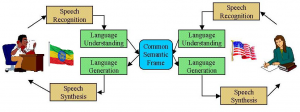
Some Basic Research areas under speech recognition/processing include but not limited to:
- Speech Synthesis – Speech Synthesis is the artificial production of human speech.
This system is called a Speech Synthesizer or Text to Speech System, and it is used for the followings:- Voice guide at station, Voice guide of car navigation system, Reading out news by cell phone, Stuffed animal that can talk - Speech recognition – Speech recognition is a processing which extracts character data by recognizing utterances. By this technology, we can operate robots or computers by our voices.
- Speech communication – Speech communication is necessary technology to answer the user’s utterance. This technology can communicate between the computer and user. Also, study of spoken dialog system has a wide-range due to this system is complicated system.
Natural Language Processing Research Area
Natural language processing software package use AI to let a user to communicate with a computer in the user’s natural language. The computer can both recognize and reply to instructions given in natural language. The penalty are of Natural Language Processing (NLP) is to plan and construct a computer system that will investigate, recognize, and produce natural human languages. Usage of NLP comprise machine transformation of one human language text to another; group of human language text such as literature, booklets, and universal explanations; interfacing to additional systems such as databases and robotic systems accordingly facilitating the use of human language type commands and enquiries; and accepting human language text to provide a summary or to appeal conclusions. One of the easiest jobs for NLP structure is to parse a sentence to govern its syntax. A more difficult assignment is defining the semantic meaning of a sentence. One of the furthermost challenge tasks is the analysis of the framework to determine the exact meaning and associating that with other text.
Some Basic Research areas under Natural Language Processing include but not limited to:
- Information Access: Building applications to improve access to information in massive text collections, such as the web, newswires and the scientific literature. Subtopics include: information extraction, text mining and semantic annotation, question answering, summarization.
- Language Resources and Architectures for NLP: Providing resources — both data and processing resources — for research and development in NLP. Includes platforms for developing and deploying real world language processing applications, most notably GATE, the General Architecture for Text Engineering.
- Machine Translation: Building applications to translate automatically between human languages, allowing access to the vast amount of information written in foreign languages and easier communication between speakers of different languages.
- Human-Computer Dialogue Systems: Building systems to allow spoken language interaction with computers or embodied conversational agents, with applications in areas such as keyboard-free access to information, games and entertainment, artificial companions.
- Detection of Reuse and Anomaly: Investigating techniques for determining when texts or portions of texts have been reused or where portions of text do not fit with surrounding text. These techniques have applications in areas such as plagiarism and authorship detection and in discovery of hidden content.
- Foundational Topics: Developing applications with human-like capabilities for processing language requires progress in foundational topics in language processing. Areas of interest include: word sense disambiguation, semantics of time and events.
- Spelling amendment, syntax checking
- Enhanced search engines
- Information mining
- Psychoanalysis, Harlequin passions
- Innovative Interfaces
- Speech appreciation (and text to speech)
- Negotiation systems
- Machine transformation
Machine Learning Research Area
Machine learning programs identify patterns in data and adjust program actions consequently. For instance, Facebook’s news feed changes according to the customer’s private communications with other consumers. If a customer regularly tags a friend in snapshots, writes on his wall or likes his/her links, the news feed will display more of that friend’s movement in the user’s news feed due to assumed closeness.
Some Basic Research areas under Natural Language Processing include but not limited to:
- Face detection in mobile camera
- Face recognition
- Image classification
- Speech recognition
- Anti-virus
- Anti-spam
- Genetics
Contact Us.

